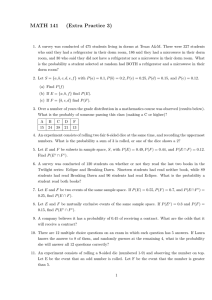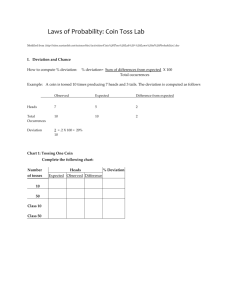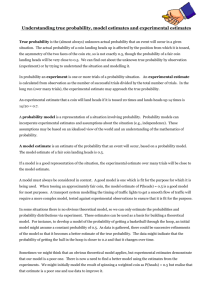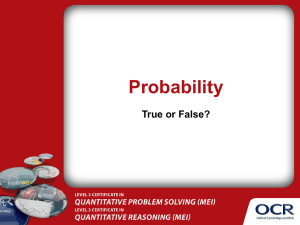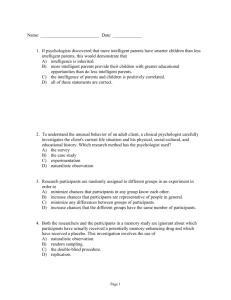MATH 141 (Extra Practice 3)
advertisement
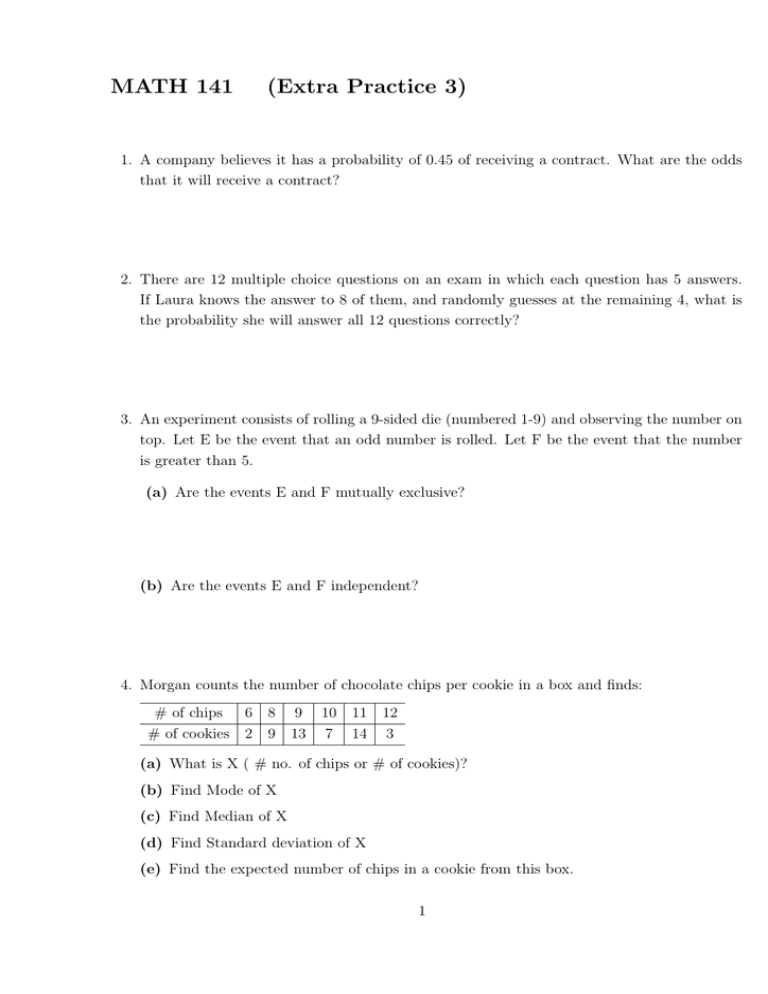
MATH 141
(Extra Practice 3)
1. A company believes it has a probability of 0.45 of receiving a contract. What are the odds
that it will receive a contract?
2. There are 12 multiple choice questions on an exam in which each question has 5 answers.
If Laura knows the answer to 8 of them, and randomly guesses at the remaining 4, what is
the probability she will answer all 12 questions correctly?
3. An experiment consists of rolling a 9-sided die (numbered 1-9) and observing the number on
top. Let E be the event that an odd number is rolled. Let F be the event that the number
is greater than 5.
(a) Are the events E and F mutually exclusive?
(b) Are the events E and F independent?
4. Morgan counts the number of chocolate chips per cookie in a box and finds:
# of chips
# of cookies
6 8 9
2 9 13
10 11
7 14
12
3
(a) What is X ( # no. of chips or # of cookies)?
(b) Find Mode of X
(c) Find Median of X
(d) Find Standard deviation of X
(e) Find the expected number of chips in a cookie from this box.
1
5. A customer at a DVD store selects four DVDs from a stack of 25 in which 6 are scratched.
What is the probability the customer selects at least 3 DVDs that are NOT scratched?
6. Use the table below to find the following: mean, standard deviation, variance, median, and
x
3 5 8 14
mode.
Frequency 15 34 26 25
7. At a school cafeteria, 400 students ate bad meat. The probability of getting food poison
from bad meat is 30%.
(a) What is the probability at most 100 students get sick?
(b) What is the probability at least 100 students get sick?
(c) What is the probability that between 120 and 180 students get sick (inclusive)?
(d) How many students can you expect to get sick?
8. In a group of 30 items on a shelf in Target store, 2 are known to be defective. If a customer
selects 3 of these items, what is the probability that at least 1 is defective?
2
9. A class takes an exam in which the average was 65.7 and the standard deviation 12.93. The
instructor decides to give F’s to 8% of the class, D’s to 18% of the class, B’s to 25% of the
class, A’s to 10% of the class, and C’s to the rest. What is the lowest grade a student can
make and still pass (assuming C or higher is passing).
10. Classify the following random variables as finite discrete, infinite discrete, or continuous. Give
the values of the random variables.
(a) A box contains 3 white, 6 purple, and 4 yellow items. Items are drawn one at a time
without replacement until a white one is drawn. Let X denote the number of items
drawn in one trial of this experiment.
(b) Let X be the temperature, in degrees Celsius, of a cup of hot tea.
(c) Let X be the number of times you roll a dice until a 5 appears.
11. The table below shows the all the grades for a certain instructor’s class over the last year.
If a student takes this class, what is the probability that the student passes (assuming D’s
and F’s are failing)?
Grade
Freq.
A B
9 18
C D
24 11
F
6
3
12. Philip pays a premium of $250 for a 3-yr-term insurance policy on his new TV set. If
something happens to the TV set, then the insurance company will pay him $3000 to replace
it. If there is a 7% chance he will need to replace the TV set within 3 years, how much
money can the insurance company expect to make/lose on this premium?
13. A game costs $2.00 to play and it consists of rolling a 10-sided die one time. If the die lands
on a 9, you win $5. If it lands on a 1 or 8, you win $3. If it lands on a 2, 3, or 4, you win $1.
For any other result, you lose. How much can a person expect to win/lose if they play this
game?
14. A manufacturer claims that the life of its tires, calculated in miles, is a normally distributed
random variable with a mean of 24,000 and a standard deviation of 1,400 miles.
(a) What is the probability that a tire will last more than 25,000 miles?
(b) If four tires are selected and experience even wear, what is the probability that all four
of them will last more than 25,000 miles?
4
15. The random variable X is normally distributed with a mean of 65 and a standard deviation
of 6. Find the percent of area under the normal curve that is within 1.5 standard deviations
of the mean.
16. The life span of a 40 watt light bulb is normally distributed with an average life span of 8,000
hours and a standard deviation of 15 days. What is the probability that a bulb selected at
random will last at least 8,250 hours?
17. The probability that a person will be color blind is 0.038. What is the probability that in a
group of 47 persons, at most 2 are color-blind?
18. Toss a fair coin 20 times. What is the probability of getting:
(a) exactly 4 heads
(b) more than 10 heads
(c) at most 15 heads
(d) between 12 and 18 heads.
5
19. A box of 24 pens contains three broken ones. If Mark selects 8 pens at random without
replacement, what is the probability that shell get at exactly 1 broken pen?
20. Let Z be the standard normal random variable. Find P (Z ≤ 0.75).
21. Laura sells magazine subscriptions over the phone. She estimates that the probability of
her making a sale with each attempt is 0.12. What is the probability of Laura making more
than 10 sales if he makes 80 calls?
22. Let Z be the standard normal random variable. Find c if:
(a) P (Z < c) = 0.234
(b) P (−c < Z < c) = 0.286
(c) P (Z > c) = 0.432
23. The weight of a length of rope will support is normally distributed with a mean of 2000 lbs
and a standard deviation of 50 lbs. What is the probability that you will buy a rope that
can support between 1900 lbs and 2050 lbs?
24. A box contains 700 small gadgets, 240 of which are cracked. If you randomly select 100
gadgets, what is the probability at least 1 is cracked? JUST SET UP THE PROBLEM
6
25. At a certain college, the rate of graduation is 64%. In a class of 1800 students, what is the
expected number of students who will NOT graduate?
26. The odds in favor of Emily remembering to do Suggested Homework problems are 2 to 10.
What is the probability she forgets and does not do the homework?
27. An experiment consists of randomly selecting one of three coins, tossing it, and observing
the outcome - heads(H) or tails(T). The first coin is a fair coin, the second coin is a biased
coin such that P (T ) = 0.15, and the third coin is a two headed coin
(a) What is the probability the coin lands on tails?
(b) Given that the coin landed on heads, what is the probability it was the fair coin?
28. A weighted coin (the probability it lands on heads is 0.63) is flipped 70 times. What is the
probability of the coin landing on TAILS at least 20 times?
7
29. A Chemistry class had an exam with an average of 68.35 and a standard deviation of 14.76.
If 6% of the class made A’s, 32% of the class made B’s, and the rest of the class made C’s,
what was the cutoff grade to make a B or higher?
30. A quiz consists of 4 TRUE/FALSE questions.
(a) In how many different ways can a person complete this quiz if every question is answered?
(b) What is the probability distribution for the number of correct answers?
31. Random drug tests were administered to 1200 high school athletes across the state. Among
the 696 girls tested, 14% of them failed the first drug test. Whereas, 27% of the boys failed
their first drug test. What is the probability a randomly selected student
(a) passed their first drug test?
8
(b) Was a boy, given they failed their first drug test?
(c) If a student failed the first drug test, they were given a second random test later that
year. Of those given the 2nd test, 5% of the girls failed it, while 13% of the boys failed
it. What is the probability a student failed the test twice?
32. Using the tree diagram below, answer the following:
0.8 ³ D
³³
³
³
A³
PP
PP
¡
PP E
¡
¡
¡
@
¡
¡
0.21
@
@ 0.44
@
@
@
0.1³ D
³³
³
³
B³
PP
PP
PP E
³D
³³
³
³
PP
C³
PP
PP
E
0.45
(a) P (D) =
(b) P (B ∩ E) =
(c) P (C ∪ D) =
(d) P (A|E) =
(e) P (E|C) =
9
33. From a pool of 120 male and 80 female applicants, 36 males and 28 females are admitted
to a certain program. Draw a tree diagram representing this scenario and label the exact
probability of each branch.
10
Answers
1. 9 to 11
2. 0.0016 obtained from binompdf(4, 1/5, 4)
3. (a) No (b) No
4. (a) # of chips (b) 11
(c) 9.5
(d) 1.440
(e) 9.604
5. 0.766
6. mean = 7.73, Stdev=3.967, Var=15.7371, median=8, mode=5.
7. (a) 0.0155,
(b) 0.9884,
(c) 0.5189,
(d) 120
8. 0.193
9. 57.3815
10. (a) Finite Discrete, X = {1, 2, 3, ..., 11}
(c) Infinite Discrete, X = {1, 2, 3, ...}.
(b) Continuous, X = {c|c is the temperature of the hot tea}
11. 0.75
12. $40
13. E(x) = −0.6, so expect to lose about 60 cents
14. (a) 0.2375,
(b) (0.2375)4 = 0.0032
15. 0.8664
16. 0.2437
17. 0.7355
18. (a) 0.0046 obtained by binompdf(20,.5,4)
(b) 0.4119 obtained from 1-binomcdf(20,.5,10)
(c) 0.9941 obtained from binomcdf(20,.5,15) (d) 0.2517 obtained from binomcdf(20,.5,18)-binomcdf(20,.5,11)
19. 0.4743 obtained by c(3, 1)c(21, 7)/c(24, 8)
20. 0.7734 using normalcdf
21. 0.3636 using 1 − binomcdf(80, 0.12, 10)
22. (a) invnorm(0.234,0,1)=-0.7257
(b) invnorm(0.643,0,1)=0.3665
23. 0.8186
C(240, 0)c(460, 100)
24. 1 −
C(700, 100)
25. 648
26. 5/6
13
≈ 0.2167
60
28. 0.9457
27. (a)
(b)
10
≈ 0.2128.
47
29. 72.8589 obtained from invnorm(0.62, 68.35, 14.76)
11
(c) 0.1713
30. (a) 16
(b) It is binomial with n=4, p=0.5, and r changing from 0, 1, 2, 3, 4.
x
P (X = x)
31. (a) 0.8054
32. (a) 0.543
0
0.0625
1
0.25
(b) 0.5827
(b) 0.189
2
0.375
3
0.25
4
0.0625
(c) 0.0188
(c) 0.741
(d) 0.1532
(e) 0.45
12



